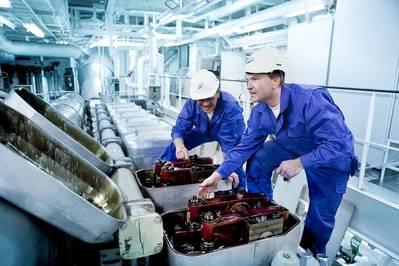“Cautious Optimism” for Goltens Dubai
The global downturn in offshore energy is well recorded, a downturn which has had impact on various arms of the energy and marine supply chain. While Goltens has felt the downturn like many other companies, it is reporting 'cautious optimism' in the Middle East premised on new international regulation and the need for shipowners to upgrade ships.
Almost all the offshore vessels in Dubai are operating, and many have come in from Asia to do the same, but following the offshore crash in 2016, operators are delaying maintenance. “People are postponing repair and maintenance, making an extension on the drydocking,” says Pravin Kirolikar, Managing Director of the Dubai branch of Goltens.
But new projects promise a reprieve for the company, as the new post-2020 reality sets in both in respect of the sulfur cap and the ballast water management convention. With the Middle East getting the lion’s share of drydocking related work – notably in 2018, more surveys were conducted at Drydocks World Dubai than any other yard in the world – and these types of jobs sometimes taking many months, Goltens Dubai certainly looks set for a yard occupancy windfall. “Business will pick up in 2019 but it’s at really cautious level,” Kirolikar says.
“Last year, the lead time of scrubbers was 18-22 months, today it’s 8-14 months. With scrubbers, availability of low-sulfur fuel will be a complicating factor. Port state restrictions – open loop, closed loop – each and every port along major trading routes have their own rules, and therefore there is a question mark on scrubbers.
Yard availability will be one issue. Cost, another. Whether the charterer is going to provide that much, that’s yet another.”
Though providing yard space will be a challenge, Goltens has a number of strategies for dealing with this, particularly in its other big retrofit segment, ballast water management. “Most of the time we can install ballast water systems – scanning, engineering, fabrication – while the vessel is in operation,” Kirolikar says.
New projects cropping up in the Middle East could revamp Goltens’ primary repair and service segment in this part of the world, offshore. New developments from the oil majors mean that more vessels will be employed, but there is considerable oversupply in the offshore segment already; Kirolikar indicates that a cautious optimism is warranted.
“We do feel that the offshore market is looking up,” he says. “There have been two new major exploration plans, including the ones from ARAMCO and ADNOC. Of course the challenge we are facing now is oversupply. This leads to challenges for the marine services provider. For us, Q2/3 is crucial, because we do see some of the offshore companies putting together a plan and we have received project enquiries for substantial conversions to be done on these vessels.
Kirolikar suggests there is scope to improve the technology currently being used in Goltens’ segment, which may help to create the new, leaner environment that today’s vessel service sector demands. “It is a question of project cash flow. This is a challenge,” Kirolikar says. “We need to align ourselves with this.
“We need to address the current situation regarding emissions and IMO regulations. We’re talking about MRV, underwater surveys; these are the aspects we are trying to move into.
“We will develop a new product to aid the customer which is developed in combination with new technology -- long term maintenance management contracts with the customer, providing the entire spectrum of services on the ship.”














